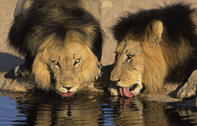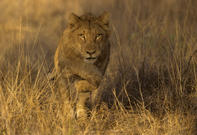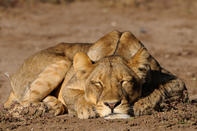Male vs Female
All the lionesses in a pride are related and remain within the pride for life. They may split up into subgroups and operate in different parts of the territory but will join up from time to time.

Young males are ousted from the pride in their third year and they must lead a nomadic lifestyle, keeping a low profile until they are able to contend for a territory from about the age of five. They are fully mature at seven years old at which time their manes are at their fullest.
After tenure of a territory, ousted older males also resort to a nomadic lifestyle and are often killed or die from lack of pride support by ten years old.
Male lions seldom kill one another unless disputing a territory but rather they take great care to avoid confrontation. Fighting creates an immediate risk of injury and any injury could imply disability in defending territory or catching food. Instead, lions spend a great deal of time advertising their position through roaring and scent-marking.
Lions mark their territories by urine-spraying bushes and other obvious objects. They defecate conspicuously and scrape with their feet on the ground where they have urinated transferring the scent to their feet to pass on while they patrol their boundaries.
Expert Stalkers

Lions are expert stalkers. They can use the barest of cover to get close to prey by holding the head and body close to the ground. With their eyes firmly fixed on the victim, they move carefully freezing immediately if the prey lifts its head.
Lions will get as close as possible to their prey before the final dash and pounce. Sometimes a chase is necessary but this is always short. Lions can cover 100 m in six seconds in a final chase. The point of attack is usually the rump or shoulders of the animal and the sheer weight of the lion causes the prey to fall, at which time it is grabbed by the throat or muzzle for the final strangulation or suffocation.
Lions will drink water regularly if it is available. They fulfill the majority of their moisture requirements from the bloody meat they eat.
Lazy Bones

Lions are extremely lethargic for the majority of their lives spending about twenty hours a day resting. This is necessary to recuperate from the intense periods they spend patrolling and hunting.
Although lions may seem comatose at times, they are often alert and can be spurred to action in seconds.
After a day’s resting and before they get active for the evening, a pride of lions will engage in contagious behaviour including yawning, grooming, defecating, urinating and communal roaring. This creates pride cohesion.
By Megan Emmett